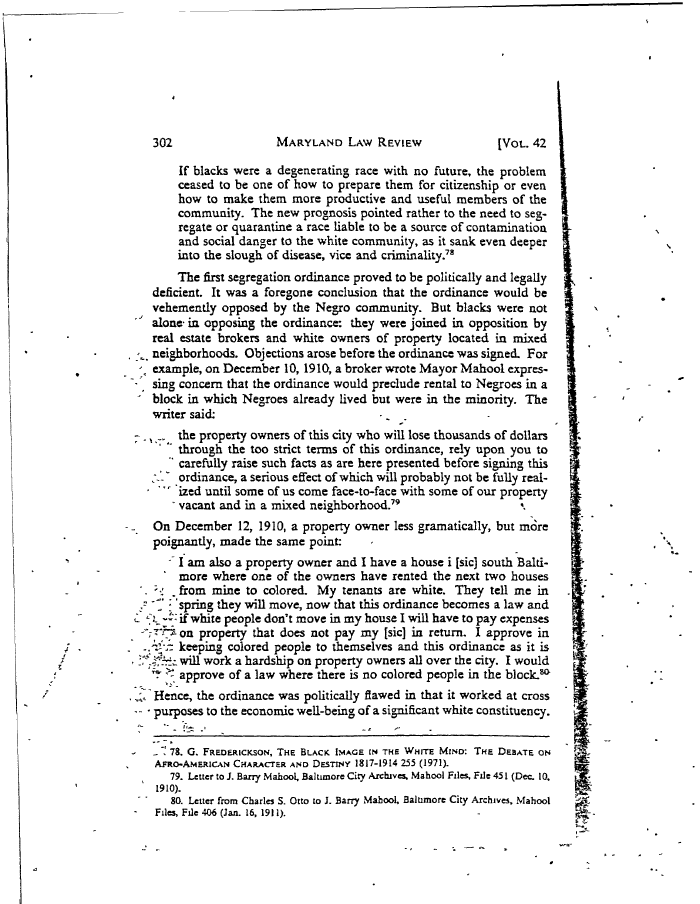 |
||||
|
Garrett Power, Apartheid Baltimore Style: The Residential Segregation Ordinances of 1910-1913, Maryland Law Review, 42 (1983) , Image No: 15 Enlarge and print image (67K) << PREVIOUS NEXT >> |
 |
||||
|
Garrett Power, Apartheid Baltimore Style: The Residential Segregation Ordinances of 1910-1913, Maryland Law Review, 42 (1983) , Image No: 15 Enlarge and print image (67K) << PREVIOUS NEXT >> |
| 302 MARYLAND LAW REVIEW [Vot. 42 If blacks were a degenerating race with no future, the problem ceased to be one of how to prepare them for citizenship or even how to make them more productive and useful members of the community. The new prognosis pointed rather to the need to seg- regate or quarantine a race liable to be a source of contamination and social danger to the white community, as it sank even deeper into the slough of disease, vice and criminality.78 The first segregation ordinance proved to be politically and legally deficient. It was a foregone conclusion that the ordinance would be vehemently opposed by the Negro community. But blacks were not alone-in opposing the ordinance: they were joined in opposition by real estate brokers and white owners of property located in mixed neighborhoods. Objections arose before the ordinance was signed. For ' example, on December 10, 1910, a broker wrote Mayor Mahool expressing concern that the ordinance would preclude rental to Negroes in a block in which Negroes already lived but were in the minority. The writer said: the property owners of this city who will lose thousands of dollars through the too strict terms of this ordinance, rely upon you to carefully raise such facts as are here presented before signing this ordinance, a serious effect of which will probably not be fully real- ized until some of us come face-to-face with some of our property vacant and in a mixed neighborhood.79 On December 12, 1910, a property owner less gramatically, but more poignantly, made the same point: • I am also a property owner and I have a house i [sic] south Baltimore where one of the owners have rented the next two houses from mine to colored. My tenants are white. They tell me in 'spring they will move, now that this ordinance becomes a law and if white people don't move in my house I will have to pay expenses on property that does not pay my [sic] in return. I approve in keeping colored people to themselves and this ordinance as it is will work a hardship on property owners all over the city. I would approve of a law where there is no colored people in the block.80 Hence, the ordinance was politically flawed in that it worked at cross purposes to the economic well-being of a significant white constituency. 78. G. FREDERICKSON, THE BLACK IMAGE IN THE WHITE MIND: THE DEBATE ON AFRO-AMERICAN CHARACTER AND DESTINY 1817-1914 235 (1971). 79. Letter to J. Barry Mahool. Baltimore City Archives, Mahool Files, File 451 (Dec. 10. 1910). 80. Letter from Charles S. Otto to J. Barry Mahool, Baltimore City Archives, Mahool Files, File 406 (Jan. 16, 1911). |